应用语言学的研究方法PPT
- 格式:ppt
- 大小:239.00 KB
- 文档页数:39
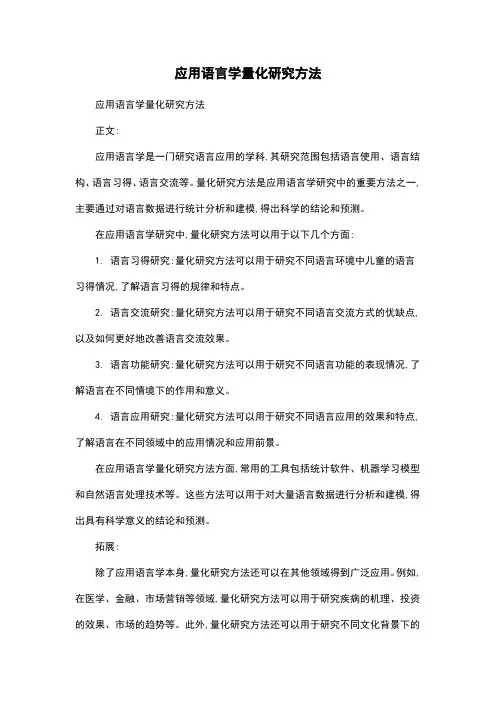
应用语言学量化研究方法
应用语言学量化研究方法
正文:
应用语言学是一门研究语言应用的学科,其研究范围包括语言使用、语言结构、语言习得、语言交流等。
量化研究方法是应用语言学研究中的重要方法之一,主要通过对语言数据进行统计分析和建模,得出科学的结论和预测。
在应用语言学研究中,量化研究方法可以用于以下几个方面:
1. 语言习得研究:量化研究方法可以用于研究不同语言环境中儿童的语言习得情况,了解语言习得的规律和特点。
2. 语言交流研究:量化研究方法可以用于研究不同语言交流方式的优缺点,以及如何更好地改善语言交流效果。
3. 语言功能研究:量化研究方法可以用于研究不同语言功能的表现情况,了解语言在不同情境下的作用和意义。
4. 语言应用研究:量化研究方法可以用于研究不同语言应用的效果和特点,了解语言在不同领域中的应用情况和应用前景。
在应用语言学量化研究方法方面,常用的工具包括统计软件、机器学习模型和自然语言处理技术等。
这些方法可以用于对大量语言数据进行分析和建模,得出具有科学意义的结论和预测。
拓展:
除了应用语言学本身,量化研究方法还可以在其他领域得到广泛应用。
例如,在医学、金融、市场营销等领域,量化研究方法可以用于研究疾病的机理、投资的效果、市场的趋势等。
此外,量化研究方法还可以用于研究不同文化背景下的
语言交流和差异,为跨文化交流和合作提供科学依据。
量化研究方法在应用语言学领域的应用越来越广泛,其重要性也越来越受到重视。
未来,随着科技的不断发展和应用的深入,量化研究方法将会在更多领域得到广泛应用,为语言研究和应用做出更大的贡献。
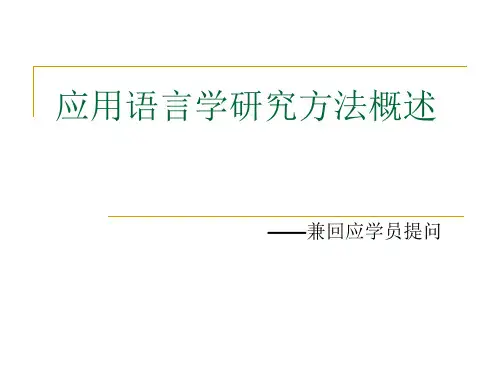


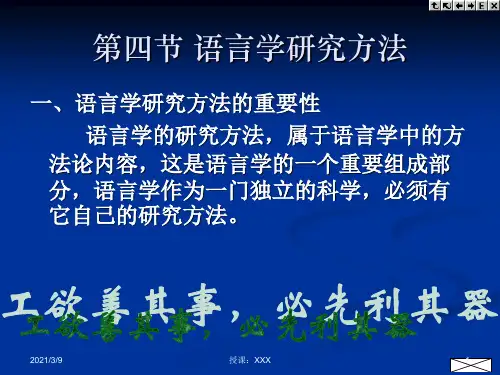


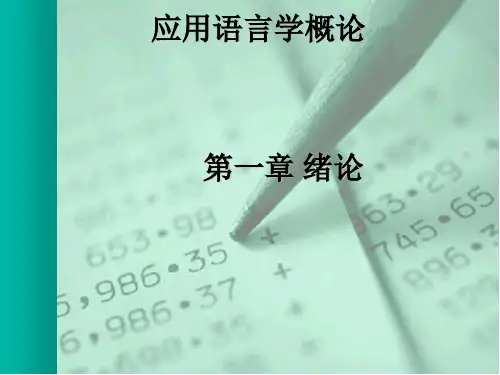

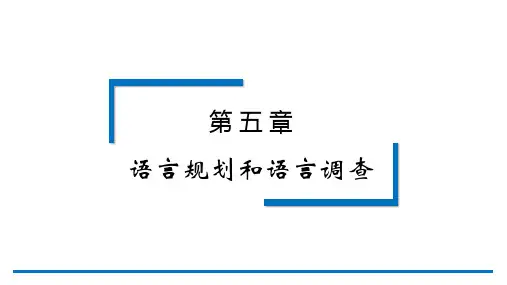

A p p l i e d L i n g u i s t i c s a n d i t s r e s e a r c h m e t h o d s⏹I. Course Overview⏹Ⅱ. Types of Research in FLL and FLT⏹Ⅲ. How to Select a Topic for Research⏹Ⅳ. Some Procedures for Data collection⏹Ⅴ.S u r v e y⏹Ⅵ. Classroom observation and case studies⏹Ⅶ. Experiment Method⏹Ⅷ. Data Analysis⏹Ⅸ. Doing ResearchI. Course Overview1. Course Name: Research Methods in Foreign Language Learning and Teaching2. Why this course?1) Problems found in the contributions to the key journals of FLT2) A preparatory course for B.A. thesis writing3. Course Objectives:1) To help learners understand research in FLL and FLT so that they can view it critically2) To train the learner to become educational researchers4. Course Materials:1) Required①Nunan, D. 1992.Research Methods in Language Learning. CUP.②刘润清,1999.外语教学中的科研方法.北京:外语教学与研究出版社③何广铿,2002.英语教学研究:理论和实践.广州:高等教育出④Papers from Journals.2) Recommended⏹Brown, J.D. 1988. Understanding Research in Second Language Learning. CUP.⏹Wallace, M.J 1998. Action Research for Language Teachers. CUP.⏹林连书. 2001. 应用语言学实验方法, 广州:中山大学出版社.⏹马广惠, 2003. 外国语言学及应用语言学统计方法. 西安: 西北农林科技大学出版社.5. Requirements:1) Reading 2) Class discussion 3) Classroom exam (write a review article)6. Methods for the Course:1) Reading 2) Discussion 3) Reporting 4) LecturingⅡ. Types of Research in FLL and FLT1. L1, L2 and FL2. What is research?1) Richards et al’s definition:⏹the study of an event, problem or phenomenon using systematic and objective methods, in order tounderstand it better and to develop principles and theories about it.2) Nunan’s definition:⏹ a systematic process of inquiry consisting of three elements or components: (1) a question, problem, orhypothesis, (2) data, (3) analysis and interpretation of data.3. Research in FLL and FLT⏹Systematic process of inquiry into the problems of FLT and FLL. It consists 3 components, i.e. problems,questions or hypotheses; data; and analysis and interpretation of data.4.Types of Research in FLL and FLT1) Qualitative vs quantitative 何广铿P.85 表5-12)C h a u d r o n’s c l a s s i f i c a t i o n(1) Psychometric (experimental)⏹Psychometric investigations seek to determine language gains from different methods and materialsthrough the use of the ‘experimental method’(2) Interaction analysis⏹Interaction analysis in classroom settings investigates such relationships as the extent to which learnerbehaviour is a function of teacher-determined interaction, and utilizes various observation systems and schedules for coding classroom interactions.(3)D i s c o u r s e a n a l y s i s⏹D i s c o u r s e a n a l y s i s a n a l y s e s c l a s s r o o m d i s c o u r s e i n l i n g u i s t i c t e r m s t h r o u g h t h e s t u d y o f c l a s s r o o mt r a n s c r i p t s w h i c h t y p i c a l l y a s s i g n u t t e r a n c e s t o p r e d e t e r m i n e d c a t e g o r i e s.(4)E t h n o g r a p h y⏹E t h n o g r a p h y s e e k s t o o b t a i n i n s i g h t s i n t o t h e c l a s s r o o m a s a c u l t u r a l s y s t e m t h r o u g h n a t u r a l i s t i c,‘u n c o n t r o l l e d’o b s e r v a t i o n a n d d e s c r i p t i o n.A.C a s e s t u d y3)B r o w n’s(1)P r i m a r y a.S u r v e yc l a s s i f i c a t i o n B.S t a t i s t i c a l(2)S e c o n d a r y b.E x p e r i m e n t a lS e c o n d a r y r e s e a r c h—k i n d o f r e s e a r c h b a s e d o n s e c o n d a r y s o u r c e s(e.g.b o o k s,p a p e r a b o u t l g.l e a r n i n g w r i t t e n b y o t h e r s c h o l a r s).⏹P r i m a r y r e s e a r c h—r e s e a r c h d e r i v e d f r o m t h e p r i m a r y s o u r c e.4)A c t i o n r e s e a r c hA c t i o n r e s e a r c h i s a f o r m o f s e l f-r e f l e c t i v e e n q u i r y u n d e r t a k e n b y p a r t i c i p a n t s i n s o c i a l(i n c l u d i n ge d u c a t i o n a l s i t u a t i o n s i n o r d e r t o i m p r o v e t h e r a t i o n a l i t y a n d j u s t i c e o fa.t h e i r o w n s o c i a l o r e d u c a t i o n a l p r a c t i c e sb.t h e i r u n d e r s t a n d i n g o f t h e s e p r a c t i c e s,a n dc.t h e s i t u a t i o n s(a n d i n s t i t u t i o n s)i n w h i c h t h e s e p r a c t i c e s a r e c a r r i e d o u t.(K e m m i s&T a g g a r t,1982:5)5.T y p e s o f r e s e a r c h i n t h i s c o u r s e1) Observation(1) Open observation (2) Participant observation2) Survey(1) Interview (2) Questionnaire3) Case study4) Experimental(1) Single group designs (2) Design using control groups5) Action researchⅢ. How to Select a Topic for Research1. Sources for general questions1)F r o m o n e’s e x p e r i e n c e a n d i n t e r e s t s(1)R u b i n’s a n d S t e r n’s R e s e a r c h⏹C e r t a i n p e o p l e a p p e a r e d t o b e e n d o w e d w i t h a b i l i t i e s t o s u c c e e d,o t h e r s l a c k e d t h o s e a b i l i t i e s.T h i so b s e r v a t i o n l e d R u b i n(1975)a n d S t e r n(1975)t o d e s c r i b e“g o o d”l a n g u a g e l e a r n e r s i n t e r m s o f p e r s o n a lc h a r a c t e r i s t i c s,s t y l e s,a nd s t r a te g i e s.R u b i n(R u b i n a n d T h o m p s o n1982)l a t e r s u m m a r i z e df o u r t e e ns u c h c h a r a c t e r i s t i c s.G o o d l a n g u a g e l e a r n e r s①f i n d t h e i r o w n w a y,t a k i n g c h a r g e o f t h e i r l e a r n i n g.②o r g a n i z e i n f o r m a t i o n a b o u t l a n g u a g e.③a r e c r e a t i v e,d e v e l o p i n g a“f e e l”f o r t h e l a n g u a g e b y e x p e r i m e n t i n g w i t h i t s g r a m m a r a n d w o r d s.④m a k e t h e i r o w n o p p o r t u n i t i e s f o r p r a c t i c e i n u s i n g t h e l a n g u a g e i n s i d e a n d o u t s i d e t h e c l a s s r o o m.⑤l e a r n t o l i v e w i t h u n c e r t a i n t y b y n o t g e t t i n g f l u s t e r e d a n d b y c o n t i n u i n g t o t a l k o r l i s t e n w i t h o u tu n d e r s t a n d i n g e v e r y w o r d.⑥u s e m n e m o n i c s a n d o t h e r m e m o r y s t r a t e g i e s t o r e c a l l w h a t h a s b e e n l e a r n e d.⑦m a k e e r r o r s w o r k f o r t h e m a n d n o t a g a i n s t t h e m.⑧u s e l i n g u i s t i c k n o w l e d g e,i n c l u d i n g k n o w l e d g e o f t h e i r f i r s t l a n g u a g e,i n l e a r n i n g a s e c o n d l a n g u a g e.⑨u s e c o n t e x t u a l c u e s t o h e l p t h e m i n c o m p r e h e n s i o n.⑩l e a r n t o m a k e i n t e l l i g e n t g u e s s e s…(2)B a i l e y’s R e s e a r c h(S a n d S p.47)⏹B a i l e y(1983)r e c o r d e d i n a d i a r y h e r o w n e x p e r i e n c e s o f l e a r n i n g F r e n c h a s a f o r e i g n l a n g u a g e.S h en o t i c e d e v i d e n c e o f c o m p e t i t i v e n e s s a n d a n x i e t y i n h e r w r i t i n g,w h i c h r a i s e d q u e s t i o n s i n h e r m i n d a b o u t w h e t h e r s u c h f e e l i n g s w e r e f a c i l i t a t i v e o r n o t.S h e t h e n r e l a t e d t h e s e e x p e r i e n c e s t o o t h e r l i t e r a t u r e d e a l i n g w i t h c o m p e t i t i v e n e s s a n d a n x i e t y i n s e c o n d l a n g u a g e l e a r n i n g.T e a c h e r s,s i m i l a r l y,m a y w i s h t o k e e pd i a r ie s of t h i ng s o b s e r v e d i n a l a n g u a g e l e s s o n o r o f a n y s t u d e n t b eh a vi o r s t h a t s e e m t o h a v e s o m e e f f e c to n l a n g u a g e l e a r n i n g.(3) Wang Qiang王蔷等(2001, 2002)(4) Yang Yang & Peng Jinxiu杨阳、彭锦秀(2004)2.C o n s i d e r a t i o n s i n S e l e c t i n g t o p i c s1)Y o u s h o u l d h a v e a p e r s o n a l i n t e r e s t i n t h e t o p i c y o u s e l e c t.2)T h e t o p i c s h o u l d b e i m p o r t a n t a n d s h o u l d m a k e a d i f f e r e n c e i n s o m e a s p e c t o f A l.3)I t i s m o r e e x c i t i n g t o e x p l o r e t o p i c s t h a t m a y l e a d t o n e w i n f o r m a t i o n.4)Y o u h a v e e n o u g h t i m e t o c o m p l e t e t h e t o p i c.5)T h e d i f f i c u l t y o f t h e t o p i c s h o u l d b e c o n s i d e r e d.2) From other’s research(1) Qi LuXia’s research (亓鲁霞的研究)(2) Nie Yuehua聂越华(2004)(3) Feng Jing冯晶(2005)3.T o p i c s e l e c t i o n b y l i t e r a t u r e r e v i e w a n d a n a l y s i s o f f e a s i b i l i t y1) Review all possible literature(1) Functions of LR⏹The function of LR. is to provide background information on the research questions, and to identifywhat others have said and/or discovered about the question so that your cut-off point is clear.(2)P l a c e s f o r s o u r c e s o f i n f o r m a t i o nA.S c h o l a r l y b o o k s(e.g.C e l c e-M u r c i a,2001)B.K e y j o u r n a l s(e.g.A p p l i e d L i n g u i s t i c s,外语教学与研究,中小学外语教学)2) Raise questions about the feasibility(1)H o w c a n t h e a n s w e r t o t h e g e n e r a l q u e s t i o n b e f o u n d?W h a t d o e s i t e n t a i l?W i l l f i n d i n g t h e a n s w e rn e c e s s i t a t e s e t t i n g u p a n e x p e r i m e n t?W i l l i t r e q u i r e t h e d e v e l o p m e n t o f a t e s t o r a s u r v e y q u e s t i o n n a i r e?(2)D o e s t h e r e s e a r c h e r h a v e t h e p r e r e q u i s i t e b a c k g r o u n d k n o w l e d g e t o i n v e s t i g a t e t h e q u e s t i o n?I s ak n o w l e d g e o f l i n g u i s t i c s o r s o c i o l i n g u i s t i c s n e c e s s a r y?H o w m u c h s t a t i s t i c a l a n a l y s i s a p p e a r s t o b ei n v o l v e d?W i l l s o m e o n e w i t h m o r e e x p e r t i s e b e r e q u i r e d?I f t h e s t u d y i s t o b e r e l a t e d t o o t h e r p e r i p h e r a la r e a s,h o w m u c h r e s e a r c h s h o u l db e d o n e b e f o r e p r oc e ed i n g t o t he n e x t p h a s e?(3)A r e t h e t e r m s a n d c o n c e p t s u s e d i n t h e f o r m u l a t i o n o f t h e g e n e r a l q u e s t i o n d e f i n e d c l e a r l y a n dc o n s i s t e n t l y?A r e t h e c o n c e p t s a nd te r m s u s e d i n a w a y t h a t i s c o n s i s t e n t w i t h h o w o t h e r r e s e a r c h e r s h a v eu s e d t h e m?(4)W h a t l o g i s t i c a l a n d p r a c t i c a l p r o b l e m s c a n b e a n t i c i p a t e d?I f t h e g e n e r a l q u e s t i o n a s k s a b o u t t h el a n g u a g e a c q u i s i t i o n o f c h i l d r e n o r a d u l t s,w i l l t h e r e s e a r c h e r h a v e a c c e s s t o t h e n u m b e r o f s u b j e c t s r e q u i r e d t o i n v e s t i g a t e t h e q u e s t i o n?I s i t n e c e s s a r y,w i l l t h e r e b e a c c e s s t o c o m p u t e r t i m e a n d a s s i s t a n c e?W i l l t h e r e s e a r c h e r n e e d t o b e t r a i n e d i n t h e u s e o f c o m p u t e r s t a t i s t i c a l a n a l y s i s s u c h a s S P S S o r S A S?Ⅳ. Some Procedures in Data Collection1. Subject Selection2. Extraneous Variables Control3. Hypothesis Formulation4. Experimental and control group Setting-up1.S u b j e c t S e l e c t i o n1) Subject: an individual who is studied in a research project.2) Population and Samples①Population⏹any set of items or individuals etc. which share some common and observable characteristics which asample can be taken.②Sample:⏹any group of individuals which is selected to represent a population.③S a m p l i n g:t h e p r o c e d u r e o f s e l e c t i n g a s a m p l eA. simple random sampling.⏹In the simple random sampling, all the individuals of the defined population have an equal andindependent chance of being selected as a member of the sample. Independent means the selection of one individual does not affect in any way the selection of any other individual.⏹We may use different procedures to do this e.g. using the random number table.B. Systematic sampling⏹It is used to obtain a sample from a defined population. This technique can be used if all members in adefined population have already been placed on a list in random order.⏹For example, we want to select 100 pupils from 1000 pupils. We can first divide the population by themember needed for the sample:1000÷100=10⏹Then we can select at random a number smaller than the number got by the division, and start with thatnumber and select every ~th name from a list of the population.⏹C. Stratified Sampling⏹A sample in which the population is grouped into several strata (e.g. of high, medium and low scores), anda selection drawn from each level, is known as a stratified sample⏹D. Volunteer Sampling④Guides to subject selectionA. To ensure that samples represent the population (lg. proficiency, sex, age, motivation etc.)B. To ensure that a minimum sample size is obtained (Charles & Merlter, 2002:154)2.E x t r a n e o u s V a r i a b l e s c o n t r o l1) Variables (变量)(1) Definition⏹ A variable is anything in the research situation that varies.⏹Are the following variables?⏹Language proficiency, motivation, aptitude, sex, age, native lg. background, time, environment, coursebook, teaching methods.2) The independent variable (自变量)⏹Variable to which different subjects are exposed to different degree.⏹It is expected to bring about a change in the dependent variable. It may be called as stimulus or input orsometimes treatment.3) The dependent variable (依变量)⏹Variable the researcher is trying to change in his research.⏹Variable which changes or is influenced according to changes in one or more independent variables.4) Extraneous variables⏹Variable that influences the results of a research project but has nothing to do with the experimenttreatment.5) Controlling the EV①Environmental variables②Subject variables (e.g.proficiency, mortality, mortality, maturation etc.)③Hawthorne effect and John Henry effect3.R e s e a r c h q u e s t i o n s a n d h y p o t h e s e s1) Research questions: A research question is the fundamental question inherent in the research topic.2) What’s a hypothesis?⏹ A statement which describes how the researcher expects his/her research to come out i.e. whatdifference or relationship he expects to find.3)C r i t e r i a f o r g o o d h y p o t h e s e s①state an expected relationship or difference between 2 or more variables.②state definite reasons for considering the hypothesis worthy of testing③be testable④be as brief and clear as possible4)T y p e s o f h y p o t h e s e s①The null hypothesis⏹It states that no relationship exists between the variables studied or no difference will be found betweenthe experimental treatments.⏹Students with low self-concept who participate in a program of bibliotherapy will show no change in theirattitude toward school.②The Directional Hypothesis (one-tailed hypothesis)It states a relationship between the variables being studied or a difference between experimental treatments that the researcher experts to emerge. (Indicating the direction of the results)Students with low self-concept who participate in a program of bibliotherapy will show improvement in their attitude toward school.③Non-directional hypothesisIt doesn’t specify the direction of changesStudents with low self-concept who participate in a program of bibliotherapy will show changes in their attitude towardschool.4.S e t t i n g u p o f t h e e x p e r i m e n t a l g r o u p a n d c o n t r o l g r o u p1) The experimental group 2) The control groupⅤ. SurveyA survey is a detailed inspection or investigation1. Types of survey1) Questionnaire (written) 2) Interview (oral)2. Steps in carrying out a survey (Nunan, 1992, PP.140—141)1) Define objectives What do we want to find out?2) Identify target population Who do we want to know about?3) Literature review What have others said/discovered?4) Determine samples How many subjects should we survey?5) Identify survey instruments How will the data be collected?6) Design survey procedures How will the data collection be carried out?7) Identify analytical procedures How will the data be analysed?8) Determine reporting procedures H o w w i l l r e s u l t s b e p r e s e n t e d?3.U s e s o f q u e s t i o n n a i r e s a n d i n t e r v i e w s1) To get opinions, ideas, experiences of our subjects2) To get data on language use in a particular community ( Bolton and Luke, 1999)4.Q u e s t i o n n a i r e d e s i g n1) Question types①Open questions ②Closed questions (Oxford, 1990; 文秋芳, 1995)2) Question wording①No leading questions ②No complex and confusing questions ③No embarrassing questions④Items should be directly referenced against one or more of the research objectives.3) Quantifying the responses —— Likert Scale5.Q u e s t i o n n a i r e a d m i n i s t r a t i o n1) Piloting — the try —out to assess its quality while it can still be revised and improved before it is usedwith the actual subjects in the research2) Administration.⏹To get a sufficient percentage of responses6. InterviewAn interview is a directed conversation between an investigator and an individual or group of individuals in order to get information, ( Richards, et al, 1998)1) Uses of interview①To get data on stages and processes of language acquisition②To assess proficiency③To investigate linguistic phenomena in communication④To get information2)T y p e s o f i n t e r v i e w①structured⏹The researcher works through a list of set questions in a predetermined order.②Semi—structured⏹The interviewer has a general idea of where he wants the interview to go, but does not enter the interviewwith a list of predetermined questions.③Unstructured⏹It is guided by the responses of the interviewee rather than the agenda of the researcher. The researcherexercises little or no control and the direction of the interview is relatively unpredetermined.S u g g e s t i o n s f o r p l a n n i n g a n d c o n d u c t i n g i n t e r v i e w s①Prepare the interview schedule⏹The list of questions used by the interviewer is known as an interview schedule.②Piloting⏹Interview questions are piloted with a small sample of subjects before being used.③Selection of subjects⏹Efforts should be made to secure a representative sample.④Good atmosphere⑤Use of recordersⅥ.C l a s s r o o m observation a n d c a s e s t u d i e s1. Observation methods⏹( in research ) procedures and techniques that are based on systematic observation of events, e.g. usingaudio and video recorders, check list, etc.⏹Observation methods are often used in studying language use and classroom events. ( Richards et al, 1998)2. Types of observation (Seliger and Shohamy, 1997)1) Non—participant observation⏹the investigator observes and records or takes notes of the observed activities, but without the control orguidance of a questionnaire or other instrument.2) Participant observation⏹In the participant observation, the researchers are the observers; they participate in the very act that theyare describing.3) Open observation and structured observation⏹In open observation, the data being recorded are broad and more general.⏹In structured observation, the researcher uses tools (instruments) to collect data.3. Uses of observation1) To observe how learners acquire or use language. (龚少瑜、陈永培,1997)2) To study the interaction between teachers and students.3) To find out how an experiment is going on.4) To find out the effect of different classroom practices on learning outcome.4. Observation scheme COLT5. Case studies⏹the systematic investigation of an individual ‘case’, whether that refers to one teacher, one learner, onegroup, one class, or whatever.6. Methods to collect data in case studies⏹a wide range of techniques can be used.1) Observation 2) Questionnaire and interview 3) Verbal report 4) TestsⅦ. Experimental Method1. Definition⏹an approach to educational research in which an idea or hypothesis is tested or verified by setting upsituations in which the relationship between different subjects or variables can be determined. Thedescription of the purposes of the research, its plan, the statistical procedures used etc., in an experimental study is called the experimental design ( Richards et al, 1998)2. The major components of experimental research1) The type and number of groups(1) “Natural” groups(2) Groups formed specially for an experiment2) The treatment⏹This refers to anything done to groups in order to measure its effect, e. g. a language teaching method,teaching materials⏹Treatments are the independent variables in the research3) Measurement or observation⏹refers to how the effects of the treatment will be evaluated or observed.X= treatmentO= observation or measurementR= randomization3. Single group design1) One shot design: XO2) One group pretest + posttest design⏹O1 X O23) Time series design⏹O1, O2, O3, O4, X, On+1, On+24. Design using control groups1) Static - group comparison design:X O1O12) Non – equivalent control group design:O1×O2O1O23) Pretest / posttest with randomization of groups:R O1X O2R O1O2↓R X O2R O24) Variation of 3)R ×O2R O25. Factorial Designs(因子设计)beginner groupR O1 Xc O2R O1 O2 beginners1—O1—Xd—O2R beginners2—O1—Xc—O2R O1 Xd O2 beginners3—O1 —— O2R O1 O2advanced groupR O1—Xc—O2R O1 O2 advanced1—O1—Xd—O2R advanced2—O1—Xc—O2R O1—Xd—O2 advanced3—O1 —— O2R O1 O26. Types of experiments1) Pre—experiment⏹May have pre and post treatment tests, but lacks a control group2) Quasi—experiment⏹has both pre and post tests and experimental group and control group, but no random assignment ofsubjects3) True experiment⏹has both pretest and posttest, experimental and control groups, and random assignment of subjectsⅧ.A c t i o n R e s e a r c h1.D e f i n i t i o nA c t i o n r e s e a r c h i s a f o r m o f s e l f-r e f l e c t i v e e n q u i r y u n d e r t a k e n b y p a r t i c i p a n t s i n s o c i a l(i n c l u d i n ge d u c a t i o n a l)s i t u a t i o n i n o r d e r t o i m p r o v e t h e r a t i o n a l i t y a n d j u s t i c e o f(a)t h e i r o w n s o c i a l o r e d u c a t i o n a lp r a c t i c e s,(b)t h e i r u n d e r s t a n d i n g o f t h e s e p r a c t i c e s,a n d(c)t h e s i t u a t i o n s(a n d i n s t i t u t i o n s i n w h i c h t h e s ep r a c t i c e s a r e c a r r i e d o u t.(K e m m i s a n d M c T a g g a r t,1982:5)2.C h a r a c t e r i s t i c s o f a c t i o n r e s e a r c h(N u n a n,1992:17-18)(1)I t i s c a r r i e d o u t b y p r a c t i t i o n e r s.(2)I t i s c o l l a b o r a t i v e.(3)I t i s a i m e d a t c h a n g i n g t h i n g s.3.S t e p s i n t h e a c t i o n r e s e a r c h c y c l e(N u n a n,1992:19)S t e p1:I n i t i a t i o n→A t e a c h e r c o m e s t o m e w i t h a p r o b l e m:H i s c u r r e n t G r o u p o f s t u d e n t s d o n o ts e e m i n t e r e s t e d o r m o t i v a t e d.W h a t s h o u l d b e d o n e?S t e p2:P r e l i m i n a r y i n v e s t i g a t i o n→W e s p e n d s o m e t i m e c o l l e c t i n g b a s e l i n e d a t a t h r o u g ho b s e r v a t i o n a n d r e c o r d i n g c l a s s r o o m i n t e r a c t i o nS t e p3:H y p o t h e s i s→A f t e r r e v i e w i n g t h e i n i t i a l d a t a,w e f o r m t h e h y p o t h e s i s t h a t t h e s t u d e n t s a r eu n m o t i v a t e d b e c a u s e t h e c o n t e n t o f t h e c l a s s r o o m i s n o t a d d r e s s i n g t h e n e e d s a n di n t e r e s t s o f t h e s t u d e n t s.S t e p4:I n t e r v e n t i o n→T h e t e a c h e r d e v i s e s a n u m b e r o f s t r a t e g i e s f o r e n c o u r a g i n g t h e s t u d e n t s t o r e l a t e t h ec o n t e n t o f t h e l e s s o n s t o t h e i r o w n b a c k g r o u nd s a n d i n te r e s t s.T h e s e i n c l u d e i n c r e a s i n g t h en u m b e r o f r e f e r e n t i a l o v e r d i s p l a y q u e s t i o n s.S t e p5:E v a l u a t i o n→A f t e r s e v e r a l w e e k s,t h e c l a s s i s r e c o r d e d a g a i n.T h e r e i s m u c h g r e a t e r i n v o l v e m e n t o f t h e s t u d e n t s,a n d t h e c o m p l e x i t y o f t h e i r l a n g u a g e a n d s t u d e n t-l e d i n t e r a c t i o n s i s e n h a n c e dS t e p6:D i s s e m i n a t i o n→T h e t e a c h e r r u n s a w o r k s h o p f o r c o l l e a g u e s a n d p r e s e n t s a p a p e r a t a l a n g u a g e c o n f e r e n c e. S t e p7:F o l l o w-u p→T h e t e a c h e r i n v e s t i g a t e s a l t e r n a t i v e m e t h o d s o f m o t i v a t i n g s t u d e n t s.4.D a t a c o l l e c t i o n t e c h n i q u e s1)D i a r y w r i t i n g a n d f i e l d-n o t e s t a k i n g2)O b s e r v a t i o n t e c h n i q u e s①V e d i o r e c o r d i n g②A u d i o r e c o r d i n g③U s i n g o b s e r v a t i o n s c h e m e s3)Q u e s t i o n n a i r e s a n d i n t e r v i e w sⅧ. Data Analysis1. Definition:⏹Data analysis refers to sifting, organizing, summarizing, and synthesizing the data so as to arrive at theresults and conclusion of the research.2. Relationship between data analysis techniques and research components⏹Apply Different data analysis techniques to different types of dataT h e r e s e a r c h p r o b l e mThe research designThe data collectedThe data analysis technique3. Analyzing the data collected in observation, survey, and case studies1) Convert the oral data into the written form(孟春国2004)2) Classify the data by looking for commonalities, regularities or patterns(1) Use an ordering system of categories that exists(2) Pay attention to inter—rater reliability and intra—rater reliability3) Quantify the data(1) Use a particular figure to represent a phenomenon(2) Use item frequencies for particular phenomenon(3) Use the mean (平均数) and standard deviation (标准差) to represent the scores’ characteristics(4) Use standard scores to represent the scoresA. Z scoreB. T scoreC. CEEB score4. Analyzing the data collected in an experimental research⏹1)H y p o t h e s i s t e s t i n g(1)s a m p l e d a t a a n d p o p u l a t i o n d a t a(2)s i g n i f i c a n c e o r s i g n i f i c a n t i n s t a t i s t i c s“p r o b a b l y c a u s e d b y s o m e t h i n g o t h e r t h a n m e r e C h a n c e.”(马广惠,2003:85)“F i n d i n g s t h a t v e r y l i k e l y h a v e n o t o c c u r r e d b y C h a n c e a r e c a l l e d‘s i g n i f i c a n t’”(C h a r l e s,C.M.&M e r t l e r,C.A.2004:385)⏹2) Steps in carrying out Hypothesis Testing(1) Formulate the statistical hypotheses(2) Select an alpha level(3) Select an appropriate statistical method(4) Compare the observed statistics and critical values••Formulate the statistical hypothesesA. statistics (统计量)and parametres (总体参数)a. When calculations are made to describe a sample sample they are called statistics. X and SDb. When the same calculations were actually done for the entire population, they would be calledparametres. μandσB. Null hypothesis and alternative hypothesisIn any study there should be at least one null hypothesis and one alternative hypothesis for each pair variables being studied.(2) Select an alpha levelA. Probability (概率) and confidence levels(置信度)a. Probability: in statistics, a concept related to chance(偶然性); is used to establish levels of confidence related to individual measures and hypothesis testing (Charles, C. M. & Mertler, C. A. 2004: 384)b. Confidence levels: indicating the probability that the population lies within certain specifiedboundaries. (ibid)(概率也常常定义为一种置信度,即人们对事情发生可能性的确信程度。